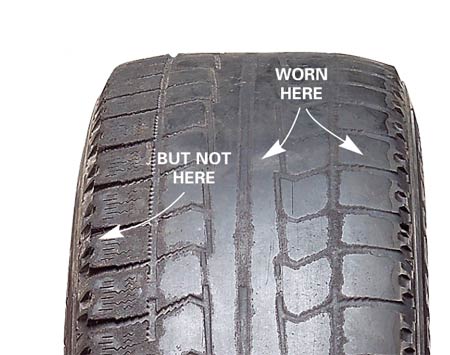
These bars of hard rubber are normally invisible but appear across treads that have been worn down to 116th of an inch of the surface of the tire the legal limit in most states. All tires sold in the US.
Positive camber caster and toe can lead to wear on the outer edge.
How to tell tire wear. Most tires have tread-wear indicators built into them see Figure 2. These bars of hard rubber are normally invisible but appear across treads that have been worn down to 116th of an inch of the surface of the tire the legal limit in most states. Diagonal Patchy Wear Time for Tire Rotation Patchy tire wear suggests your tires are out of balance.
There will be tread on the sides of the tire and a smooth narrow strip of wear around the center of it. This is mostly caused by tires that are overinflated. When a tire is overinflated the tire in essence bulges out more in the center.
The tire then rides mostly on that bulge and that bulge wears faster than the sides of the tire. If your tire is showing you increased wear along both edges outside and inside simultaneously with the middle of the tire featuring significantly less wear this is an indicator that the tire is underinflated. Positive camber caster and toe can lead to wear on the outer edge.
If you see edge wear on one side check the thrust and setback. Positive camber caster and toe can lead to wear on the outer edge. If you see edge wear on one side check the thrust and setback.
When these bars become visibly flush with the adjacent ribs the tire has no more than 232 of tread remaining. By holding Abraham Lincolns portrait towards the hubcap and checking how high the rubber reaches on the coin you can tell if your tires need to be replaced. Consistent wear around the whole tire is normal but uneven tread wear could be a sign of improper inflation wheel misalignment or a variety of other things.
Your tires may have to show even wear across the tread or the deals off. You may also have to show receipts that verify you had the tires rotated at the prescribed. Center wear is when your tire is worn down the middle and caused by over-inflation.
Shoulder wear happens when the sides of the tire wear quicker than the middle of the tire and tends to be caused by under-inflation. A misalignment could also cause wear issues especially when theres excessive wear on the camber or toe. The tire wear bars run laterally left to right across the tread grooves on your tires.
Along with the initial penny test described above the wear bars are an indication of 232 tread remaining ie. When the tread bars are even with the surrounding tread then its time to replace tires. Excessive wear in center tread indicates over inflation of the tire.
Excessive wear on shoulders may signal problems such as under inflation of the tire. Uneven tread wear indicates poor wheel alignment. Excessive wear on one side of the tire signals incorrect camber angle.
All tires sold in the US. And most other countries have tread wear barssmall horizontal bridges that form between your treads at a lower depth. As your tires wear these bars become flush with the tread.
When the tire tread is even with these wear bars it means the tread is worn to 2 32 inch 016 cm and needs to be replaced immediately. Road tires dont have a noticeable tread pattern but one way to notice wear is the formation of a flat surface down the centre line and a squaring off to the side walls. Using a tire on a stationary trainer speeds this up.
Tire wear is to your cars suspension what blood pressure and pulse rate are to your heart and diagnosing tire wear patterns can tell you as much as an EKG readout would to a doctor. A good diagnostician is much like a doctor examining data that might mean very little to anyone else and reading into it to uncover the the problem it indicates.
